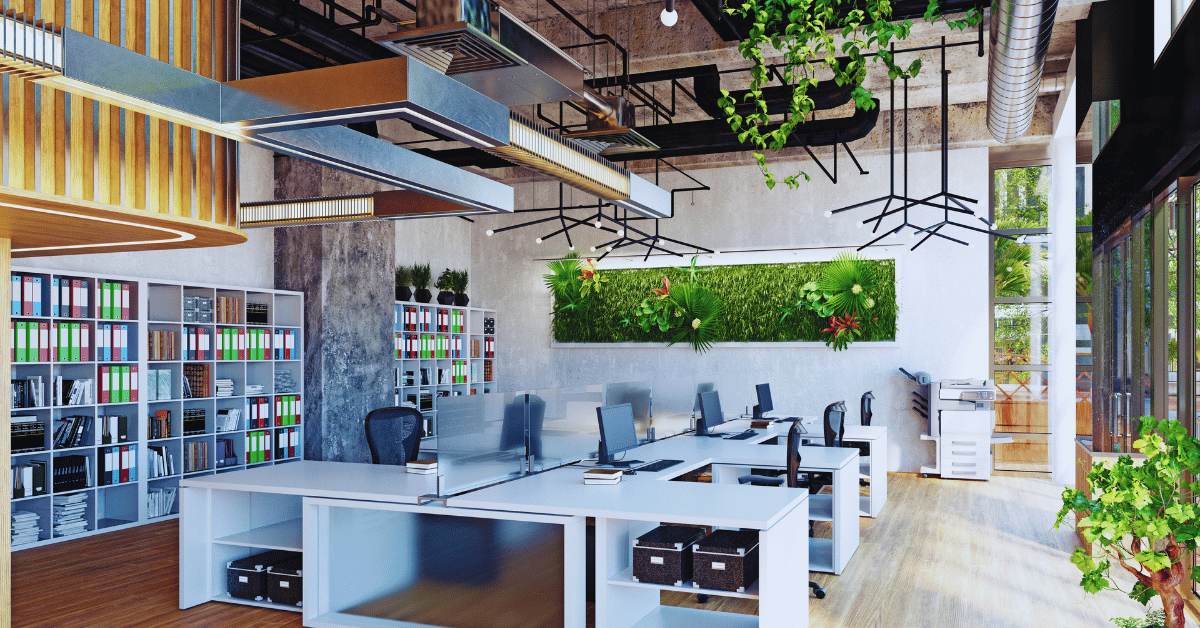In an era where inclusivity is paramount, office furniture designs are transforming to accommodate the diverse needs of all employees. Whether it’s adjustable desks or ergonomic chairs, the focus is on ensuring every employee can thrive in the workplace, regardless of physical ability. Accessibility in office design isn’t just a trend—it’s a crucial aspect of creating a dynamic, inclusive workspace where everyone feels empowered to contribute.
Introduction
In today’s modern work environment, inclusivity and accessibility are crucial to ensuring all employees can contribute to their fullest potential. Office furniture designs play a pivotal role in creating accessible workplaces. By prioritizing ergonomic and accessible office furniture, companies can enhance employee comfort, Productivity, and well-being.
The Importance of Accessible Office Furniture
Key Features of Accessible Office Furniture
Adjustable Height Desks
One of the standout features of accessible office furniture is the adjustable height desk. These desks offer flexibility for users to change the workstation’s height according to their preferences and needs, making them an essential tool for an inclusive workspace. Employees can adjust the desk to maintain optimal comfort and Productivity, whether standing or sitting. For individuals with mobility challenges or those who use wheelchairs, adjustable desks allow them to easily accommodate their specific requirements, fostering a more inclusive work environment.
Beyond accessibility, adjustable-height desks also promote health benefits. The ability to alternate between sitting and standing throughout the day helps reduce the risks associated with prolonged sitting, such as poor posture, back pain, and cardiovascular problems. This flexibility also enhances energy levels, as standing intermittently boosts circulation and reduces fatigue, ultimately contributing to increased Productivity.
In a diverse workplace where employees have varied needs, adjustable desks ensure everyone has equal access to a comfortable and functional workspace. Whether it’s adjusting the desk to fit a wheelchair, changing the height for standing, or customizing it for an employee’s ergonomic preferences, adjustable height desks provide a simple yet powerful solution for workplace accessibility.
Ergonomic Office Chairs
Ergonomic chairs are a critical component of accessible office design, offering superior comfort and support for employees of all physical capabilities. These chairs are designed to be highly adjustable, allowing users to modify seat height, armrest positioning, and back support to match their body type and work preferences. This adaptability ensures that each employee can customize their seating to reduce strain on the body and improve posture during long hours at the desk.
The lumbar support feature of ergonomic chairs is essential for preventing lower back pain, a common issue among office workers. By promoting natural spine alignment, ergonomic chairs help reduce the risk of musculoskeletal disorders, including neck strain and carpal tunnel syndrome. For employees with physical disabilities or chronic conditions, these chairs provide the additional support necessary to maintain comfort throughout the day.
Furthermore, ergonomic office chairs promote overall well-being by encouraging movement. Many models allow for reclining and tilting, enabling users to change positions frequently and maintain better circulation. This reduces the risk of discomfort and stiffness often resulting from sitting in one position for extended periods. These chairs are not just about comfort but also crucial in promoting long-term health and workplace safety.
Accessible Storage Solutions
Accessible storage solutions are essential for creating a fully inclusive office environment. Office spaces that lack easy-to-reach shelves, drawers, or cabinets can create unnecessary barriers for employees with mobility limitations. By incorporating accessible storage solutions, businesses ensure that all employees have equal access to essential documents, tools, and equipment, regardless of their physical capabilities.
These solutions often include adjustable shelving that can be lowered or raised depending on the user’s height or mobility needs and easy-to-open cabinets and drawers that require minimal effort. Storage placed at the right height ensures that employees with physical limitations, such as those in wheelchairs, can comfortably access their belongings without assistance. In addition to physical accessibility, many modern storage solutions are designed with ergonomics, reducing the need to bend, stretch, or strain when retrieving items.
Accessible storage is also about convenience and efficiency. Having easily reachable storage areas reduces time spent searching for items and enhances Productivity by ensuring that necessary resources are within arm’s reach. This setup also minimizes the risk of injury, as employees don’t have to overextend or put themselves in awkward positions to retrieve items.
In more advanced setups, intelligent storage systems can also be incorporated into accessible furniture design. These systems feature automated components, such as push-button drawers or motorized shelves, making it even easier for individuals with physical challenges to access and organize their workspace.
Mobility-Friendly Layouts and Additional Features
In addition to the core furniture items like desks, chairs, and storage solutions, a genuinely accessible office must incorporate a mobility-friendly layout. This involves designing the workspace with wide aisles, unobstructed pathways, and clear sightlines to ensure employees with mobility devices, such as wheelchairs or walkers, can easily navigate the office. Proper furniture placement and layout design help avoid crowding and bottlenecks, which can create challenges for employees with physical limitations.
To further enhance accessibility, some offices are integrating assistive technology into their furniture designs. For example, height-adjustable desks can be operated via remote controls or mobile apps, making it even easier for users with limited mobility to adjust their workspace. Similarly, motorized drawers and filing cabinets are becoming popular, allowing for smooth and easy operation with minimal physical effort.
Additional ergonomic features such as footrests, keyboard trays, and monitor arms can also be integrated into the office furniture design. These items help employees maintain proper posture, prevent strain, and enhance overall comfort, ensuring the workspace is as user-friendly as possible.
Benefits of Accessible Office Furniture
Enhanced Productivity
Employees naturally increase productivity when they are comfortable and can work without physical strain. Office furniture designed with accessibility reduces discomfort and allows workers to focus more on tasks. Ergonomic furniture that meets diverse needs creates a smoother, more efficient workflow.
Improved Workplace Inclusivity
Accessible furniture creates an inclusive environment where every employee feels valued and supported regardless of physical ability. This inclusivity fosters a sense of belonging and motivates employees to contribute more effectively. With accessible furniture, no one feels left out, creating a harmonious workplace.
Reduced Workplace Injuries and Health Issues
Accessible office furniture, particularly ergonomic chairs and desks, reduces the risk of workplace injuries, such as musculoskeletal disorders (MSDs), common in office environments. Ergonomically designed furniture supports proper posture, minimizes repetitive strain injuries, and alleviates pressure on joints and muscles. In the long term, this reduces absenteeism due to health issues, as employees experience fewer work-related absences, such as back or neck pain.
Boosted Employee Morale and Job Satisfaction
When employees know their company is invested in creating a comfortable and accessible workspace, it boosts their morale and job satisfaction. Accessible furniture demonstrates that the company values its well-being, which, in turn, makes employees feel appreciated and more motivated to perform their best. A supportive workplace environment can increase retention rates and encourage loyalty among employees.
Compliance with Legal and Ethical Standards
Many countries have laws and regulations that mandate workplace accessibility, such as the Americans with Disabilities Act (ADA) in the United States or similar rules in other regions. By investing in accessible office furniture, companies ensure they comply with these legal requirements. Failing to provide an accessible workspace can result in legal repercussions, financial penalties, and damage to the company’s reputation. Proactively incorporating accessible furniture helps avoid these issues while demonstrating the company’s ethical commitment to creating a fair and inclusive workplace.
Increased Employee Retention
Providing accessible office furniture can lead to more excellent employee retention. When employees feel that their workplace is designed with their comfort and accessibility in mind, they are more likely to stay with the company long-term. By creating an inclusive and comfortable environment, companies reduce turnover and the costs of recruiting and training new staff. Retaining employees also ensures continuity and helps maintain a high level of expertise within the organization.
Flexibility for a Diverse Workforce
Accessible office furniture is inherently adaptable and versatile, accommodating various physical needs. This flexibility benefits not only employees with disabilities but also those with temporary conditions (like an injury or pregnancy) or different ergonomic preferences. It allows companies to cater to a diverse workforce and create an environment that supports everyone’s unique needs. As the workforce becomes more diverse, having furniture that adapts to various requirements is crucial to ensuring inclusivity and comfort for all employees.
Steps to Ensure Office Furniture Designs Support Workplace Accessibility
Assess the Needs of Your Workforce
Start by assessing your employees’ specific needs. Consider conducting a survey or meeting to identify areas for accessibility improvements. Understanding your workforce’s challenges will help you select the right furniture.
Partner with Furniture Specialists
Work with professional office furniture suppliers who specialize in ergonomic and accessible designs. These experts can provide guidance on the best products to suit your workplace needs. Investing in high-quality, accessible furniture is a commitment to your team’s well-being.
Regularly Review and Update
Office environments and employee needs evolve. Regularly reviewing and updating your office furniture ensures that it continues to meet the needs of all employees. As workplace dynamics change, so should the furniture to accommodate new accessibility needs.
Overview of Ensuring Office Furniture Designs Support Workplace Accessibility
Accessible office furniture is essential to creating a workplace where all employees can perform to the best of their abilities, regardless of physical challenges. This approach ensures inclusivity, enhances Productivity, and promotes employee well-being.
| Company Name | Increased Productivity (%) | Employee Satisfaction (%) | Reduction in Absenteeism (%) |
|---|---|---|---|
| Tech Innovators Ltd | 25% | 90% | 15% |
| Creative Solutions Co | 30Absenteeism | ||
| future Designs LLC | 22% | 88% | 18% |
| Global Tech Hub | 28% | 92% | 17% |
| Bright Spaces Inc | 26% | 89% | 16% |
Challenges and Solutions for Office Furniture Accessibility
| Challenge | Solution |
|---|---|
| Desk Heights: Fixed desk heights that are not adjustable pose difficulties for individuals using wheelchairs or those with varying mobility needs. | Adjustable desks, allowing customization to accommodate different heights and mobility requirements. |
| Chair Design: Chairs without proper lumbar support or armrests that hinder lateral movement can be problematic for individuals with certain physical conditions. | Ergonomic chairs with adjustable lumbar support and armrests provide the necessary comfort and flexibility for diverse needs. |
| Workspace Layout: Cluttered or narrow pathways between workstations can create challenges for people with mobility aids or vision impairments. | Thoughtful layout planning, incorporating more comprehensive pathways and organized spaces, promotes easy navigation for everyone. |
| Technology Integration: Office furniture with poorly placed power outlets or inaccessible technology hinders individuals with disabilities. | Inclusive office furniture design includes convenient access to power sources and strategically placed technology for universal use. |
| Color and Contrast: Furniture finishes and materials that lack color contrast may pose challenges for individuals with visual impairments. | Choosing materials with distinct colors and incorporating contrast helps individuals perceive and navigate the workspace more easily. |
| Adaptable Workstations: Fixed workstations may limit the ability to accommodate personal adjustments for different users. | Adopting adaptable workstations with height-adjustable desks and customizable accessories promotes a flexible and inclusive workspace. |
| Collaboration Spaces: Collaborative office furniture without consideration for diverse needs may exclude some individuals from participation. | Designing collaborative areas with various seating options and inclusive arrangements ensures everyone can engage comfortably. |
Increased Productivity (%)
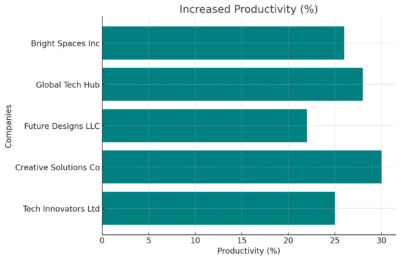
This Horizontal Bar Chart highlights the increased productivity percentages across different companies.
Importance:
- Clear comparison: The horizontal bars make it easy to compare Productivity across companies.
- Space-efficient: Ideal for displaying longer company names, ensuring clear visibility and comparison.
Employee Satisfaction (%)
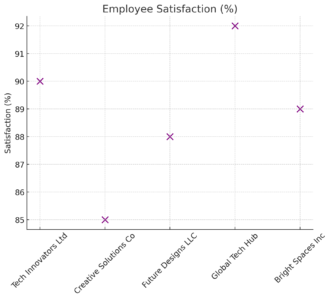
This Scatter Plot displays the employee satisfaction percentages across different companies.
Importance:
- Individual data points: Each company is represented as a distinct point, making it easy to see variations in satisfaction levels.
- Precise distribution: Ideal for spotting outliers or companies with significantly higher or lower satisfaction than others.
Reduction in Absenteeism (%)
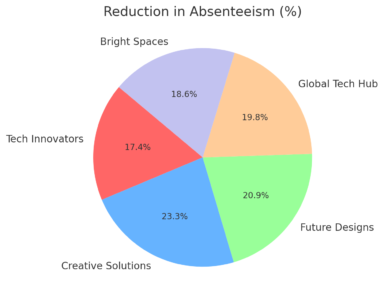
This Pie Chart illustrates the reduction in Absenteeism in different companies.
Importance:
- Proportional clarity: It helps visualize how much each company contributes to overall absenteeism reduction, making it easy to see which organizations perform better in managing Absenteeism.
- Quick comparison: Allows for a fast understanding of the reAbsenteeismormance of each company.
Productivity and Satisfaction Comparison (%)
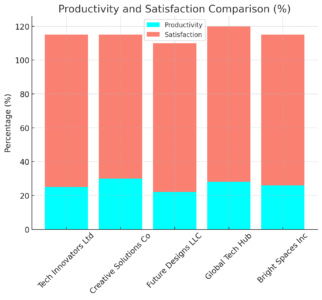
This Stacked Column Chart compares productivity and satisfaction percentages for each company, showing the combined total in a clear, layered format.
Importance:
- Dual comparison: A side-by-side comparison of Productivity and satisfaction, revealing the relationship between these metrics for each company.
- Overall view: Stacked bars offer a combined look at both variables, helping identify companies that excel in both areas or show discrepancies between Productivity and satisfaction.
Key Takeaways
- Accessible office furniture supports the diverse needs of employees.
- Key features include adjustable height desks, ergonomic chairs, and accessible storage solutions.
- Implementing accessible furniture enhances productivity and workplace inclusivity.
- It’s essential to regularly assess, partner with specialists, and update furniture as per evolving workforce needs.
Related Posts:
- Which Type of Furniture is Most Desirable for an Office?
- What Are the Key Features to Look for in Office Chairs in Dubai?
- Modern Ergonomic Furniture in Dubai 2024
- Essential Office Furniture in Dubai for Productive Workspaces
- What to Look for in an Office Furniture Store: A Comprehensive Guide
Conclusion
Creating an accessible office space requires attention to detail in furniture design. Investing in ergonomic and accessible office furniture supports employees and fosters a culture of inclusivity and Productivity. By incorporating office furniture in Dubai, companies can ensure that they meet the diverse needs of their workforce, enhancing Productivity, improving job satisfaction, and reducing Absenteeism. Implementing these practices creates a dynamic and inclusive Absenteeismronment where all employees can thrive.
For businesses looking to invest in accessible and ergonomic office furniture in Dubai, Furnicraft is the go-to solution. With a wide range of modern, high-quality, and adaptable furniture, Furnicraft ensures that your office is functional and promotes employee well-being and inclusivity. Whether you need adjustable desks, ergonomic chairs, or accessible storage solutions, Furnicraft provides the perfect blend of comfort, design, and accessibility to create the ideal workspace.
If you are searching for
- Office Furniture Stores in Dubai
- Modern Office Furniture in Dubai
- Office Furniture Store Dubai
- Office Furniture in Dubai
- Office Furniture Company in Dubai
- Luxury Office Furniture Dubai
- Office Furniture Suppliers in Dubai
- Best Office Furniture in Dubai
Contact us today to learn more about our premium office furniture in Dubai!

